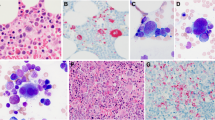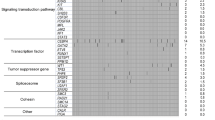Abstract
Driver genomic alterations in pediatric immature T-cell acute lymphoblastic leukemia are not fully known. We report two cases of novel EVX fusions involved in the transcriptional activation of HOX family genes, ETV6::EVX2 and MSI2::EVX1/HOXA13, which activate HOXD and HOXA cluster genes transcription through enhancer hijacking. HOXA and HOXD were the only key transcription factors activated in these cases, which indicates their important roles in leukemogenesis. Our findings elucidate potential drivers for development of T-cell lymphoblastic leukemia, and are valuable for diagnosis and risk stratification of pediatric T-ALL in the era of precision medicine.



Similar content being viewed by others
Data availability
The data that support the findings of this study are openly available in [repository name] at [URL].
References
Coustan-Smith E, Mullighan CG, Onciu M, Behm FG, Raimondi SC, Pei D, et al. Early T-cell precursor leukaemia: a subtype of very high-risk acute lymphoblastic leukaemia. Lancet Oncol. 2009;10(2):147–56.
Belver L, Ferrando A. The genetics and mechanisms of T cell acute lymphoblastic leukaemia. Nat Rev Cancer. 2016;16(8):494–507.
Graux C, Cools J, Michaux L, Vandenberghe P, Hagemeijer A. Cytogenetics and molecular genetics of T-cell acute lymphoblastic leukemia: from thymocyte to lymphoblast. Leukemia. 2006;20(9):1496–510.
Soulier J, Clappier E, Cayuela JM, Regnault A, García-Peydró M, Dombret H, et al. HOXA genes are included in genetic and biologic networks defining human acute T-cell leukemia (T-ALL). Blood. 2005;106(1):274–86.
Liu Y, Easton J, Shao Y, Maciaszek J, Wang Z, Wilkinson MR, et al. The genomic landscape of pediatric and young adult T-lineage acute lymphoblastic leukemia. Nat Genet. 2017;49(8):1211–8.
Yang W, Cai J, Shen S, Gao J, Yu J, Hu S, et al. Pulse therapy with vincristine and dexamethasone for childhood acute lymphoblastic leukaemia (CCCG-ALL-2015): an open-label, multicentre, randomised, phase 3, non-inferiority trial. Lancet Oncol. 2021;22(9):1322–32.
Cui L, Li ZG, Chai YH, Yu J, Gao J, Zhu XF, et al. Outcome of children with newly diagnosed acute lymphoblastic leukemia treated with CCLG-ALL 2008: The first nation-wide prospective multicenter study in China. Am J Hematol. 2018;93(7):913–20.
Scott MP. A rational nomenclature for vertebrate homeobox (HOX) genes. Nucleic Acids Res. 1993;21(8):1687–8.
Hnisz D, Weintraub AS, Day DS, Valton AL, Bak RO, Li CH, et al. Activation of proto-oncogenes by disruption of chromosome neighborhoods. Science. 2016;351(6280):1454–8.
Beroukhim R, Zhang X, Meyerson M. Copy number alterations unmasked as enhancer hijackers. Nat Genet. 2016;49(1):5–6.
La Starza R, Pierini V, Pierini T, Nofrini V, Matteucci C, Arniani S, et al. Design of a comprehensive fluorescence in situ hybridization assay for genetic classification of T-cell acute lymphoblastic leukemia. J Mol Diagn. 2020;22(5):629–39.
Bond J, Marchand T, Touzart A, Cieslak A, Trinquand A, Sutton L, et al. An early thymic precursor phenotype predicts outcome exclusively in HOXA-overexpressing adult T-cell acute lymphoblastic leukemia: a group for research in adult acute lymphoblastic leukemia study. Haematologica. 2016;101(6):732–40.
Bergeron J, Clappier E, Cauwelier B, Dastugue N, Millien C, Delabesse E, et al. HOXA cluster deregulation in T-ALL associated with both a TCRD-HOXA and a CALM-AF10 chromosomal translocation. Leukemia. 2006;20(6):1184–7.
Liu Y, Li C, Shen S, Chen X, Szlachta K, Edmonson MN, et al. Discovery of regulatory noncoding variants in individual cancer genomes by using cis-X. Nat Genet. 2020;52(8):811–8.
Zhang J, Ding L, Holmfeldt L, Wu G, Heatley SL, Payne-Turner D, et al. The genetic basis of early T-cell precursor acute lymphoblastic leukaemia. Nature. 2012;481(7380):157–63.
Seki M, Kimura S, Isobe T, Yoshida K, Ueno H, Nakajima-Takagi Y, et al. Recurrent SPI1 (PU.1) fusions in high-risk pediatric T cell acute lymphoblastic leukemia. Nat Genet. 2017;49(8):1274–81.
Parihar M, Gupta A, Remani AS, Bhattacharyya A, Mishra DK, Chandy M. Novel t(2;12)(q31;p13) in a case of pediatric T-cell acute lymphoblastic leukemia. J Pediatr Hematol Oncol. 2014;36(5):e313–5.
Acknowledgements
This work was supported by the following projects: National Natural Science Foundation of China (81970163 and 82170218 to SH), Jiangsu Project (BE2021654 to SH), Suzhou Project (GSWS2020039 to SH), the National Clinical Research Center for Hematological Disorders (2020ZKPB02 to SH), Shanghai Key Laboratory of Clinical Molecular Diagnostics for Pediatrics (20dz2260900 to YL) and Innovative research team of high-level local universities in Shanghai (to YL).
Author information
Authors and Affiliations
Contributions
XZ put all data together and drafted this manuscript. BC and YL analyzed the data. ZL interpreted the fusion genes’ action and JZ collected the clinical data. PX and JL made the treatment decision. XC, ZW and JC did RT-PCR for monitoring the MRD. YL and SH designed the study, reviewed the cases, and revised the manuscript.
Corresponding authors
Ethics declarations
Conflict of interest
The authors declare that they have no conflict of interest.
Ethical approval
The studies involving human participants were reviewed and approved by the Ethics Committee of the Children’s Hospital of Soochow University. Written informed consent to participate in this study was provided by the participants’ legal guardian/next of kin. Written informed consent was obtained from the individual(s), and minor(s)’ legal guardian/next of kin, for the publication of any potentially identifiable images or data included in this article.
Additional information
Publisher's Note
Springer Nature remains neutral with regard to jurisdictional claims in published maps and institutional affiliations.
Supplementary Information
Below is the link to the electronic supplementary material.
About this article
Cite this article
Zhang, X., Cui, B., Li, Y. et al. Transcriptome sequencing identifies novel EVX fusions involved in transcriptional activation of HOX family genes in pediatric immature T-cell acute lymphoblastic leukemia: two cases reports and a literature review. Int J Hematol 118, 508–513 (2023). https://doi.org/10.1007/s12185-023-03619-6
Received:
Revised:
Accepted:
Published:
Issue Date:
DOI: https://doi.org/10.1007/s12185-023-03619-6




